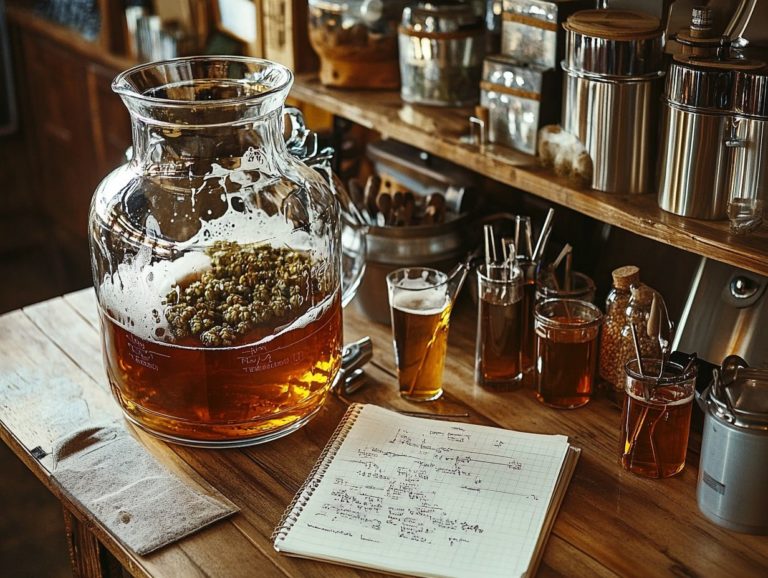10 Tips for Brewing with Local Ingredients
Contents
- 10 Tips for Brewing with Local Ingredients
- Key Takeaways:
- 1. Research and Source Local Ingredients, such as those from Thomas and Northern Brewer
- 2. Understand the Flavor Profiles of Local Ingredients, including grains, hops, and yeast
- 3. Experiment with Different Combinations and Techniques
- 4. Consider Seasonal Availability and Local Sources
- 5. Use Fresh Ingredients and Know Your Equipment
- 6. Incorporate Local Herbs and Spices for Unique Fermentable Sugars
- 7. Support Local Farmers and Businesses for Sustainable Craft Beer
- 8. Try Different Brewing Techniques and Use High-Quality Brewing Equipment
- 9. Be Mindful of the Environmental Impact
- 10. Share Your Local Brew with Others
- What Are the Benefits of Using Local Ingredients in Brewing?
- What Are the Challenges of Brewing with Local Ingredients?
- How Can One Incorporate Local Ingredients into Different Types of Beer?
- What Are Some Unique Local Ingredients to Try in Brewing?
- Conclusion
- How Can One Support the Local Community Through Brewing?
- Frequently Asked Questions
- 1. What is the importance of using local ingredients in brewing?
- 2. Where can I find local ingredients for brewing?
- 3. How can I ensure the freshness of local ingredients?
- 4. What are some tips for incorporating local ingredients into my brewing process?
- 5. Can local ingredients affect the overall cost of brewing?
- 6. Are there any specific types of local ingredients that work best for brewing?
10 Tips for Brewing with Local Ingredients
Start your brewing adventure by researching and sourcing local ingredients. This elevates not just the flavor and uniqueness of your craft beer but also nurtures a profound connection to your community and environment.
In this article, you will uncover ten invaluable brewing tips that can transform your brewing experience beginning with the art of sourcing fresh, local ingredients and delving into the intricacies of their flavor profiles while embracing seasonal varieties.
You ll also explore the benefits and challenges that come with local brewing, gaining insights on how to actively support local farmers and businesses like Schoolhouse Brewing.
Immerse yourself in the joy of crafting exceptional brews that truly celebrate the bounty of your region while minimizing fermentation flaws and oxidation.
Key Takeaways:

- Respect the local community and environment by sourcing fresh, seasonal, and sustainable ingredients.
- Explore new flavor profiles and expand your brewing skills by incorporating local herbs, spices, and produce. Document everything to track your improvements and changes.
- Support local farmers and businesses like Brew Hardware or Yakima Valley Hops while sharing your unique and delicious local brew with others.
1. Research and Source Local Ingredients, such as those from Thomas and Northern Brewer
Researching and sourcing local ingredients is the essential first step in crafting exceptional homebrew beer. It allows you to create unique flavor profiles while supporting your community and ensuring the utmost freshness.
Organize brew day to streamline your brewing process and maximize efficiency. Local farms often provide fresh grains, malt extract, and hops that can significantly enhance your brewing process, contributing to the overall quality and taste of your beer.
By tapping into local resources, you not only minimize your carbon footprint and oxidation but also cultivate meaningful relationships with farmers, establishing a sustainable supply chain for your future brewing endeavors.
Incorporating locally sourced grains, barley, and hops gives you the chance to experiment with distinctive flavors and characteristics that reflect your region’s unique identity. Freshness is paramount in brewing; the closer you are to the source, the higher the quality of your ingredients, which in turn promotes optimal yeast health and fermentation.
Engaging with local farmers supports the community and provides you with invaluable insights into the agricultural practices that shape your ingredients. This collaboration ultimately results in better beer, as seasonal variations and local terroir are beautifully highlighted in every sip. Incorporating elements such as yeast health and fermentation techniques can further enhance the quality of your brew.
2. Understand the Flavor Profiles of Local Ingredients, including grains, hops, and yeast
Understanding the flavor profiles of local ingredients is essential for you as a homebrew beer enthusiast. Different hops, grains, and yeast varieties can dramatically change the taste and aroma of your final product, which is crucial in avoiding fermentation flaws.
By experimenting with various combinations, you have the opportunity to unlock unique characteristics that reflect your surroundings. For example, if you choose a hop varietal like Cascade, you’ll notice it imparts a delightful citrusy aroma, while using Munich malt can enhance sweetness, crafting a rich, malty backbone.
Regarding yeast, opting for a strain such as Belgian Witbier yeast introduces fruity esters and subtle spice, elevating the overall complexity of your brew. Sourcing local ingredients like New York state-grown hops or California grains not only supports regional agriculture but also adds distinctive profiles to your creations, whether you’re crafting an IPA or a stout.
It’s this intricate interaction between these elements that transforms each brew into your personal masterpiece.
3. Experiment with Different Combinations and Techniques
Experimenting with different ingredient combinations is one of the most exhilarating aspects of homebrewing beer. It allows you to uncover innovative flavors and styles that truly set your craft beer apart. Try using extract brewing methods with various fermentable sugars for different flavor outcomes.
By incorporating a variety of hops like aromatics and bittering hops at different stages you can unleash a symphony of aromas and tastes, transforming your brews into something exceptional. Exploring various malt extracts will contribute to a richer, more complex profile that beautifully complements the hops. Don t forget to chill wort quickly to preserve these delicate flavors.
Embracing diverse fermentation techniques such as temperature variations and different yeast strains opens the door to fascinating final products. Documenting each experiment and adjusting variables like fermentation time deepens your understanding of brewing chemistry and refines your methods over time.
This creates a unique brewing style that showcases your creativity, making each batch a true reflection of your craft.
4. Consider Seasonal Availability and Local Sources
Considering the seasonal availability of ingredients is crucial for you as a homebrewer, ensuring that you re using the freshest hops, grains, and other components that can significantly enhance your brewing process.
In spring, you can savor the bright, floral flavors of freshly harvested hops, which lend a unique aroma to your pale ales and IPAs. Summer typically ushers in an abundance of wheat and fruity adjuncts, perfect for crafting refreshing wheat beers and delightful fruit-infused styles. Autumn brings hearty grains like barley and rye, offering deeper, more complex flavors ideal for stouts or porters. Winter often presents opportunities to experiment with adjuncts like spices and holiday flavors.
By planning your brew days around these seasonal harvests, you not only capture the essence of each season but also maximize the freshness of your ingredients. This approach allows for vibrant flavor profiles that can truly elevate your homebrew creations.
5. Use Fresh Ingredients and Know Your Equipment

Using fresh ingredients is essential in homebrewing beer; the quality of your hops, grains, and yeast can significantly affect the final product’s flavor and overall quality. Knowing your equipment and how to sanitize everything is equally important for maintaining quality.
The health of your yeast hinges on the freshness of these components. Stale or oxidized ingredients can introduce off-flavors and disrupt fermentation, leading to outcomes that fall short of your expectations. Fresh ingredients not only supply the vital nutrients that yeast need for optimal fermentation but also help reduce oxidation, often the source of undesirable flavors. This is crucial in achieving optimal yeast health.
To achieve the best results, consider sourcing hops from local suppliers like MoreBeer or farmers’ markets, where they’re typically harvested and sold soon after picking. Opting for freshly milled grains maximizes flavor and character, while selecting high-quality, active yeast strains enhances fermentation efficiency.
Always ensure that your ingredients are stored correctly, and check the dates to confirm their freshness.
6. Incorporate Local Herbs and Spices for Unique Fermentable Sugars
Incorporating local herbs and spices into your homebrew beer opens up a world of unique flavors and aromas. This allows you to craft signature brews that truly reflect your region s character.
These additions can provide unique fermentable sugars that contribute to the flavor complexity. By experimenting with various combinations, you can elevate your creations, transforming standard recipes into extraordinary concoctions.
For instance, consider the fragrant notes of coriander to enhance a Belgian witbier, or zesty orange peel to bring brightness and depth to your brew. Utilizing a brew kit can help you manage these ingredient additions effectively.
During the boiling stage, these ingredients release their essential oils, infusing your beer with a delightful complexity. Timing is crucial here; adding spices too early can lead to overpowering flavors.
On the other hand, late additions provide a fresher taste that can really make a difference. Don t forget to sanitize everything to avoid contamination.
The secret lies in striking the perfect balance, ensuring that the spices harmonize beautifully with the malt and hops. This results in a well-rounded brew that tantalizes the palate and leaves a lasting impression.
7. Support Local Farmers and Businesses for Sustainable Craft Beer
Supporting local farmers and businesses enriches your community while simultaneously elevating the quality of your homebrew beer. By sourcing fresh, regional ingredients, you can capture the unique essence of local terroir in every sip.
Local terroir refers to the unique environment and conditions where ingredients are grown. This contributes to a more sustainable and authentic brewing process.
When you cultivate strong relationships with nearby suppliers of brewing equipment and ingredients, you re not just making a purchase; you re nurturing a sense of community that champions sustainable practices.
These partnerships foster transparency and traceability in sourcing, helping ensure that you know where your ingredients come from. This enables small-scale farmers and artisans to flourish within the local economy.
Utilizing locally sourced ingredients allows you to craft unique flavor profiles that reflect the distinct climate and soil conditions of your region. This collaboration enhances the quality of your beer.
It also creates a network of shared values centered on sustainability. This brings together brewers, farmers, and consumers in a beautifully interconnected way.
Companies like Northern Brewer and Yakima Valley Hops are great examples of this collaborative spirit.
8. Try Different Brewing Techniques and Use High-Quality Brewing Equipment
Exploring different brewing techniques can dramatically elevate your homebrew experience. This allows you to delve into various methods that enhance both flavor and efficiency throughout the brewing process.
Using high-quality brewing equipment like a propane burner or bottle caps from reliable suppliers such as Brew Hardware can make a significant difference.
Consider extract brewing, which simplifies the journey and offers quicker turnaround times. Alternatively, dive into all-grain brewing, where you can exert greater control over flavors and ingredients.
Each method presents its own unique advantages, making the choice a matter of personal preference and brewing goals. Extract recipe kits from suppliers like MoreBeer can be a great start for beginners, offering a convenient way to experiment with new techniques.
One critical aspect of both techniques is the necessity of rapidly chilling the wort after boiling. This step not only mitigates the risk of contamination but also helps preserve that delightful hop aroma you re aiming for.
To ensure a seamless brew day, organize your ingredients and brewing equipment ahead of time. This preparation will streamline your process, reduce stress, and ultimately lead to a successful fermentation.
This results in a rich and flavorful final product that you can take pride in. Chill the wort quickly to prevent any unwanted side effects, and make sure you know your equipment well.
9. Be Mindful of the Environmental Impact
Being aware of the environmental impact of brewing is essential for you as a homebrew beer enthusiast. By choosing sustainable practices, you can significantly reduce your carbon footprint and promote ecological responsibility.
Implementing brewing tips, such as using fresh ingredients and minimizing oxidation, can further enhance your eco-friendly approach. One effective way to achieve this is by sourcing local ingredients. This not only supports nearby farmers and suppliers but also minimizes transportation emissions, positively impacting the environment.
You can also minimize waste in your brewing process by reusing spent grains as animal feed or composting leftover materials. Adopting energy-efficient equipment and practices like utilizing solar power or energy-efficient heating methods will help you lower energy consumption.
By embracing these eco-friendly choices, you enjoy cost savings and a unique flavor profile from local ingredients while fostering community engagement and collaboration. Together, you can create a thriving brewing culture that benefits everyone!
Sanitize everything to ensure the highest quality of your brews and reduce contamination.

Sharing your local brew with others cultivates a vibrant community spirit while deepening the appreciation for craft beer. It provides an opportunity for homebrew enthusiasts like yourself to showcase your creations and receive invaluable feedback.
Organize brew day events to engage with others and enhance your brewing experience. When you host local tasting events or participate in community festivals, you encourage fellow brewers and beer lovers to unite, fostering an atmosphere rich in friendship and collaboration.
These gatherings are more than mere showcases of unique flavors and brewing techniques; they act as platforms for exchanging ideas. The camaraderie that develops often sparks collaborative brewing efforts, ultimately strengthening the bonds within your local brewing community.
Engaging with others who share your passion for craft beer can ignite your creativity and innovation, creating an environment where everyone has a role in the art of brewing. Thomas from Schoolhouse Brewing often emphasizes the importance of community in brewing.
What Are the Benefits of Using Local Ingredients in Brewing?
Using local ingredients in your brewing offers numerous benefits that extend beyond taste. Imagine enjoying fresher flavors and enhanced quality in your homebrew beer while simultaneously forging stronger connections within your community each pint supports local economies and promotes sustainable practices.
These locally sourced ingredients reveal a spectrum of unique flavor profiles, elevating your craft beer experience to new heights. When you embrace this practice, you can create distinctive brews that reflect the unique characteristics of your local environment, setting your creations apart from the mass-produced offerings of larger breweries.
By prioritizing sustainable sourcing, you not only improve the environmental footprint of your production but also cultivate meaningful relationships with local farmers and producers, enriching the fabric of the community. This collaborative effort enables the local economy and allows you, as a beer enthusiast, to savor brews that embody authentic regional characteristics, deepening your connection with every sip.
Start brewing with local ingredients today!
What Are the Challenges of Brewing with Local Ingredients?
Brewing with local ingredients poses a few challenges that you ll need to navigate carefully. Variability in ingredient quality, potential fermentation flaws, and limited availability can all impact your homebrew beer production process.
These hurdles can lead to inconsistent flavor profiles. This makes it tricky for you to achieve that perfect taste you re aiming for. Managing oxidation to preserve freshness is essential. It is also critical to ensure the health of your yeast throughout the brewing journey.
To tackle these issues effectively, it’s crucial to select high-quality local ingredients that have proven their worth. Documenting each step of your brewing process will allow you to pinpoint and correct any potential flaws. Regular sampling along the way will also be beneficial, enabling you to monitor fermentation progress and make timely adjustments to enhance the flavor and aroma of your final product.
Pay attention to fermentation flaws and keep oxidation low to ensure the best quality of your beer.
How Can One Incorporate Local Ingredients into Different Types of Beer?
Incorporating local ingredients into your various beer styles requires thoughtful consideration of how these elements will interact. This ultimately shapes the desired flavor profile and texture of your final product.
Understanding the unique characteristics of regional products can unlock exciting twists on classic styles. For instance, when brewing a hoppy IPA, consider swapping out traditional hops for local varieties. This can introduce unexpected flavor notes that beautifully complement seasonal fruits from your area. It’s also important to consider the impact of your yeast selection and temperature control to highlight these local flavors.
When crafting stouts, the inclusion of locally sourced specialty grains or chocolate can add depth while preserving a rich mouthfeel. Don t underestimate the importance of adjusting the temperature and yeast selection during fermentation. These factors can unveil latent flavors in your ingredients that truly reflect the local terroir.
Balancing sweetness with bitterness is crucial. This allows the final brew to showcase the local contributions in perfect harmony.
What Are Some Unique Local Ingredients to Try in Brewing?
Exploring unique local ingredients in your brewing journey can unlock thrilling new flavors! This can enhance your craft beer experience and push the boundaries of flavor in your homebrew creations. Breweries such as Yakima Valley Hops and MoreBeer offer a variety of local ingredients worth trying.
Take, for example, the use of German Hallertau hops, celebrated for their delicate floral aroma. These can elevate a traditional lager to remarkable new heights. Consider incorporating locally grown grains, like malts sourced from a nearby farm, which can provide a distinctive regional character that truly sets your beer apart.
Imagine adding native fruits such as Oregon blueberries or Michigan cherries! Not only do they introduce a delightful sweetness, but they also bring a vibrant hue and added complexity to your brew. Spices like New Mexico’s Hatch green chiles can infuse a surprising kick, transforming an ordinary ale into a memorable masterpiece. Using fermentable sugars from these ingredients can also enhance the brewing process.
These unique ingredients do more than just enhance flavors; they highlight regional identities and resonate with consumers who crave authentic and innovative brewing experiences.
Start your craft brewing adventure today by sourcing local ingredients that will transform your beer! Don’t miss out on the opportunity to elevate your brewing with local ingredients that are fresh and available today!
Conclusion
Using local ingredients not only enhances the flavor of your beer but also connects you to your community and the environment. We encourage you to share your experiences with brewing and explore the vast array of unique local options available to you.
How Can One Support the Local Community Through Brewing?

Supporting your local community through brewing is not just a rewarding pursuit; it s a powerful way to forge connections, uplift local businesses, and promote sustainable practices within the craft beer industry.
This community-focused philosophy manifests in various ways, such as sourcing ingredients from local suppliers. Not only does this elevate the freshness and flavor of your brews, but it also fosters strong relationships with local farmers. By partnering with these agricultural collaborators, you re injecting vitality into the local economy, ensuring that every dollar spent on ingredients stays within the community s ecosystem. Brew Hardware can be an excellent source for local brewing supplies.
Engaging in community events like farmers’ markets or festivals provides you with the perfect platform to showcase your craft while connecting directly with consumers. These meaningful interactions cultivate brand loyalty and inspire community members to rally behind local establishments, creating a beneficial relationship that enriches both your brewery and the surrounding area.
Frequently Asked Questions
1. What is the importance of using local ingredients in brewing?
Local ingredients enhance the flavor and character of your beer. They also support local businesses and farmers.
2. Where can I find local ingredients for brewing?
You can find local ingredients at farmers’ markets, specialty stores, or by connecting with local farmers and suppliers.
3. How can I ensure the freshness of local ingredients?
Ensure freshness by purchasing ingredients directly from the source. Choose reputable suppliers with a quick turnover of products. Companies such as Northern Brewer and Schoolhouse Brewing offer a wide range of fresh ingredients for all your brewing needs.
4. What are some tips for incorporating local ingredients into my brewing process?
Some tips include experimenting with different ratios and combinations of ingredients. Use them as late additions for more pronounced flavors, and properly sanitize them before use. Document everything to keep track of what works best and what needs adjustment.
5. Can local ingredients affect the overall cost of brewing?
In some cases, using local ingredients may be more expensive than traditional brewing ingredients. However, the benefits of supporting local businesses and the potential for unique flavors make it worth the cost. Consider investing in a quality brew kit to get started with local ingredients.
6. Are there any specific types of local ingredients that work best for brewing?
It ultimately depends on personal preference and the type of beer being brewed. However, some commonly used local ingredients include fruit, herbs, honey, and grains such as wheat or barley. Remember, fresh ingredients are crucial for a quality brew!
Organizing your brew day and knowing your equipment can make a significant difference in the brewing process. Don t forget the importance of sanitizing everything to avoid fermentation flaws and oxidation. If you’re using extract brewing methods, which involve using pre-made malt extracts instead of raw grains, malt extract and fermentable sugars are essential. Keep your yeast health in check, chill wort quickly, and document everything to improve over time.






